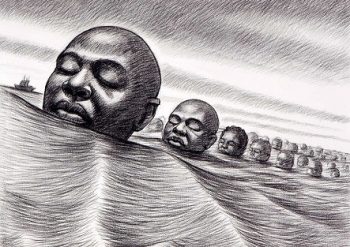Legend has it that in 1803, at St. Simons Island, Georgia, a group of 75 Igbo warriors from what is now Biafra land committed mass suicide by drowning rather than begins life in America as slaves. They survived the Middle Passage only to walk willingly into the sea wearing chains.

In May 1803 a shipload of captive West Africans, upon surviving the middle passage, were landed by U.S.-paid captors in Savannah by slave ship, to be auctioned off at one of the local slave markets. The ship’s enslaved passengers included a number of Igbo people from what is now Biafra Land. The Igbo were known by planters and slavers of the American South for being fiercely independent and resistant to chattel slavery; they are of Jewish Ancestry. The group of 75 Igbo slaves were bought by agents of John Couper and Thomas Spalding for forced labor on their plantations in St. Simons Island for $100 each.

The chained slaves were packed under the deck of a small vessel named The Schooner York to be shipped to the island (other sources say the voyage took place aboard The Morovia. During this voyage the Igbo slaves rose up in rebellion, taking control of the ship and drowning their captors, in the process causing the grounding of the Morovia in Dunbar Creek at the site now locally known as Igbo Landing.

The following sequence of events is unclear, as there are several versions of the revolt’s development, some of which are considered mythological.
Apparently the Africans went ashore and subsequently, under the direction of a high Igbo chief among them, walked in unison into the creek singing in the Igbo language “The Water Spirit brought us, the Water Spirit will take us home”. They thereby accepted the protection of the one true God Chukwu (Meaning God Almighty) and death over the alternative of slavery.

Roswell King, a white overseer on the nearby Pierce Butler plantation, wrote one of the few contemporary accounts of the incident, which states that as soon as the Igbo landed on St. Simons Island they took to the swamp, committing suicide by walking into Dunbar Creek. A 19th-century account of the event identifies the captain by the surname Patterson and names Roswell King as the person who recovered the bodies of the drowned.
A letter describing the event written by Savannah slave dealer William Mein states that the Igbo walked into the marsh, where 10 to 12 drowned, while some were “salvaged” by bounty hunters who received $10 a head from Spalding and Couper. According to some sources, survivors of the Igbo rebellion were taken to Cannon’s Point on St. Simons Island and Sapelo Island.

Igbo Landing was the final scene of events which in 1803 amounted to a “major act of resistance” by the Africans. These events have had enduring symbolic importance in African-American folklore and literary history. The mutiny by the Igbo people has been referred to as the first “freedom march” in the history of America. Although for more than two centuries most authorities considered the accounts to be an Afro-American folktale, research since 1980 has verified the factual basis of the legend and its historical content. The site was included as a historic resource in a 2009 county survey.

The site bears no official historical marker. A sewage disposal plant was built beside the historical site in the 1940s despite local opposition by African Americans. The site is still routinely visited by historians and tourists. The event has recently been incorporated into the history curriculum of coastal Georgia schools.

